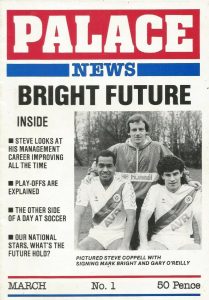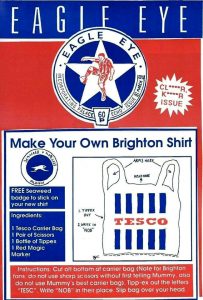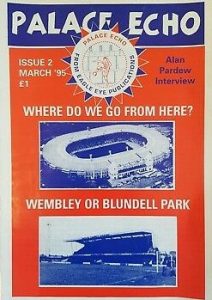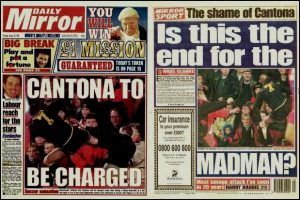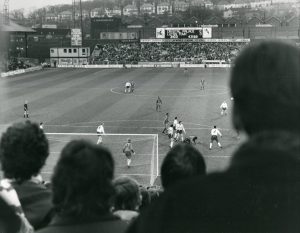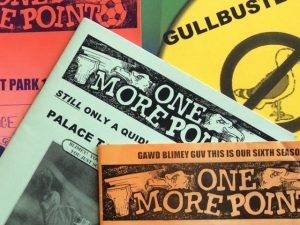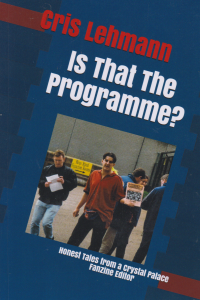
Cris Lehmann’s book gets nearer than most to the heart of the football fanzine revolution. This is because its central theme is the hard graft that went into conceiving, creating and bringing a publication to market in a pre-internet, pre-Windows and pre-computer age. However glossy and professional it may been by the time of its 2003 demise, One More Point began life – as did all the era’s fanzines – as a Heath Robinson collage cobbled together on works photocopiers from press cuttings, contributions begged off mates in pubs and fonts appropriated from “proper” publications, notably the Panini Football 90 sticker album. The text was run off using a daisy wheel printer so eccentric that it was a matter of luck whether the page would end on either side of a line of text or plough straight through the middle.

And that was just the beginning. The finished product then needed printing, folding, stapling and selling in sufficient quantities to cover costs and ideally leave a few quid over for beer and/or travel to the next away game. Ever wondered why fanzine vendors are so evangelical? A need to recoup overheads is the answer. The product is time-bound, because things change fast in football and no-one wants to read last month’s news. And it’s also at the whim of postponements, bad weather, getting beaten up for no good reason in the Luton Yates’s and – quite frequently in this author’s case – the risk of people overdoing their pre-match drinking to the extent they’re unfit to speak, let alone sell anything.
- excluded
- inspiration
- evolution
These are the practicalities. What about art? Love of the game and your team are givens, and in explaining why he decided to go into editorship Cris further describes how “What you were about to buy was not connected to or owned by any club…….you and I could contribute as well.” This will resonate with those of us who were there, and so too will the increasing sense of disenfranchisement felt by fans as the Sky era started to bite. One More Point drew a lot of inspiration from the groundbreaking Eagle Eye (previously, and subsequently, Palace Echo) which – reflecting sadly on the commercial focus of official publications – concluded “When I read Palace News now I feel a little excluded. They’re not talking about the Palace I know. It sounds like someone else’s club.”
The backdrop to the book is a circumscribed and highly-eventful four-season spell taking in Palace’s ill-deserved relegation from the Premier League in 1993, the Division One title-winning season that followed, further demotion in 1995 and play-off defeat to Leicester the year after. There was plenty going on to keep a fanzine busy but still one incident dominates. Leaving aside the rights and wrongs of what actually happened, the consequences rippling outwards from Eric Cantona’s infamous kung-fu kick were many. Arguably one of them was, as Cris cogently and compassionately suggests, the death of a Palace fan before the next meeting of the two sides in the 1995 FA Cup semi-final at Villa Park. This is sensitive territory and his treatment of it is admirable.
Sensitivity isn’t much in evidence when a well-oiled Cris finds himself in the players’ lounge following a characteristic bit of blagging. “These players were heroes to me”, he laments, “but one by one I was pissing them off and I really didn’t mean to.” First he annoys the frankly scary Eric Young by asking him to comment on a 90 Minutes expose of his reclusive habits. Next up is Chris Coleman, whose wife understandably objects to an attempt to fix him up with a girl at Cris’ work. And to round things off Cris’ even more inebriated mate prostrates himself in front of a bemused Chris Armstrong. The result? “The players’ lounge became a lot more better managed, ie no more Holmesdale riff-raff in there, and it was many more years before we ever got back in.”
The book is loaded with similar anecdotes. Ray Houghton comes close to ripping the author’s head off on one occasion, having mistaken him for the editor of Eagle Eye and being less than impressed by the latter’s relentless lampooning of Darren Pitcher (the real culprit was stood nearby at the time, keeping very quiet). There are ejections by over-zealous police, a wrongful arrest for illegal street trading and – again as you would expect – no end of escapades, scrapes and the odd unlooked-for scuffle. We also see plenty of bets and dares, my favourite being the lad who elects to have “CPFC” shaved onto his head in, of all places, Wolverhampton. Except that rather than carving the letters into his hair, the barber leaves the initials standing out on a bare scalp……
Three decades after the genesis of One More Point fanzines are still eagerly bought on a matchday. These range from survivors of the first generation such as King of the Kippax, 4,000 Holes, A Kick Up The ‘Rs and The Pie to more recent creations like Everton’s excellent The Black Watch and Doncaster’s aptly-named Popular Stand. The spirit of rebellion which forced fans onto street corners back in the day is still very much alive. Its drivers during the Eighties were mistreatment at the hands of police and demonisation by polite society, while nowadays the grievances concern brand exploitation and consumer manipulation. But marginalisation of supporters is an enduring common denominator. It’s thanks to the likes of Cris that our clubs are occasionally reminded why we matter.
Is That The Programme: Honest Tales From A Crystal Palace Fanzine Editor is available from Amazon in Kindle (£4.99) or paperback (£9.99).

